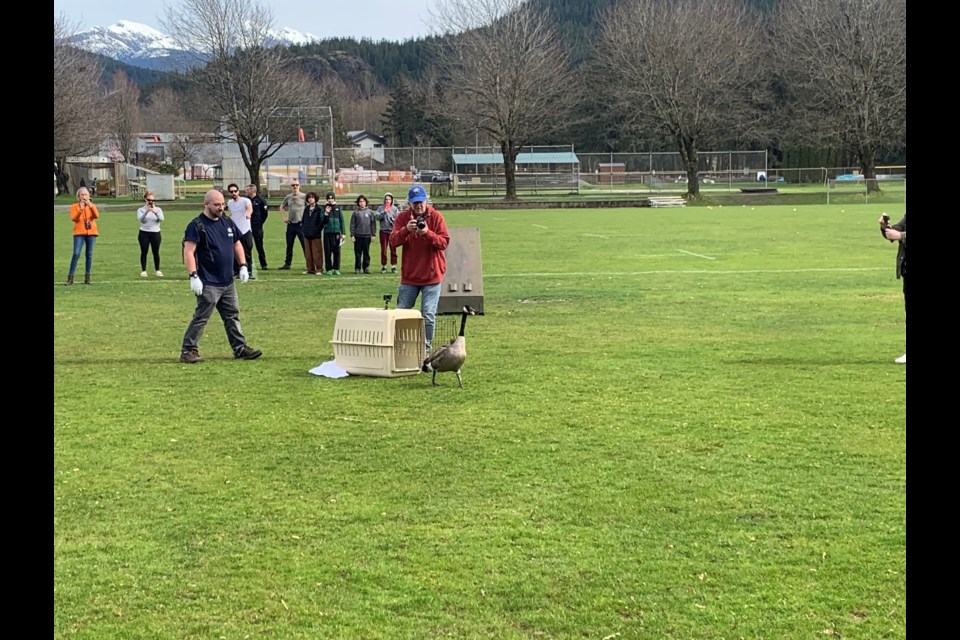Wilson, the Squamish Canada goose, having recovered from having an arrow in its rump, was set free today at Brennan Park field, to cheers—and a few joyful tears—from those in the crowd who came out to watch.
The goose, which was named by locals after the volleyball in the movie Cast Away, was shot with a plastic arrow near Sechelt last year.
The arrow was embedded in the left flank of the goose, leaving the arrow trailing out behind its back end.
He made his way to Squamish, where he was tracked by local Tim Cyr and other naturalists for about seven months.
Cyr spearheaded a GoFundMe campaign that raised $3,330 from supporters locally and beyond for a net gun to capture the bird.
Wilson was finally captured by wildlife biologist Myles Lamont of TerraFauna Wildlife Consulting at Furry Creek in mid-January.
After a visit to the vet for surgery, he was transferred to MARS Wildlife Rescue, located near Courtenay on Vancouver Island, to recover and rebuild his strength.
Before the release, Cyr noted it had been quite a “long haul” for the beleaguered bird.
“It will be really satisfying to see him finally get released after all he's been through. He will see me and probably say, ‘Oh no, not him again,’” he said.
“He's probably pretty sick of humans and can't wait to be released.”
Cyr did the honours of opening the cage to set Wilson free in front of a cloud of about 50 onlookers and supporters.
Dylan Doucet, from MARS, helped take care of Wilson during his recovery.
He was on hand for the release and said he had to clean Wilson's arrow wound regularly, something the bird was not too fond of.
“He wasn't too bad. He only bit me four or five, six times, probably more. But no, he was fairly well behaved,” Doucet said, with a laugh.
Dr. Adrian Walton, the vet who took the arrow out of Wilson back in January, was also on hand, taking time out from his work at the Dewdney Animal Hospital in Maple Ridge. He teared up watching Wilson fly free.
Before the release, Walton examined Wilson in his cage and gave him the all clear to fly.
He said what he wanted to see on his release from his cage, was Wilson walk and then fly away from the cage toward a gaggle of geese nearby, which is what Wilson did.
“My main takeaway from this is that this has been a community thing,” Walton said, commending all the people and organizations involved that got Wilson to his release.
'Incredibly complex' creature
Megan Erickson, acting wildlife rehabilitation manager for the MARS said Wilson's chances of survival are pretty good.
"Considering how well he coped with the arrow, we expect him to thrive without the arrow. He does have a very small limp that is the result of the arrow going through muscle and tissue, however, it shouldn't impact him too much, if at all," she said.
For Wilson to be released, MARS rehabilitation staff looked for several things.
First was making sure the wound was completely healed, and there were no signs of infection, Erickson said.
"Secondly, we wanted to make sure that his walk and paddle abilities were good enough to release, that he didn't have too many hindrances from where the injury was located," she added.
Thirdly, staff needed to make sure Wilson's waterproofing was perfect.
"Because geese spend so much of their time on the water, we can't have their feathers in poor condition," she said.
Asked why she thinks the public has been so invested in Wilson's care, when lots of birds and other animals are injured every day, Erickson said she thinks what really touched people about this case was that someone clearly targeted him.
They shot him with an arrow that wasn't meant to kill, it was meant to inflict as much pain as possible without killing, she explained.
"And to do this out of hunting season as well. This tugs on people's heartstrings," she said. "Even though Canada geese are considered a nuisance and most people don't like them, it's still a living, breathing animal that feels pain, and has feelings."
She said that geese are "incredibly complex" creatures who mate for life, and are "amazing" parents.
"While they are quite aggressive, and lots of people are afraid or don't necessarily like them, for someone to want to harm one of these intelligent animals for fun upsets a lot of people," she said.
She hopes that what readers take away from Wilson's story is that almost everything humans do impacts wildlife.
"People developing land reduces habitat for animals. Highways create zones where wildlife get hit with vehicles, homes and office buildings have windows that birds will fly into. Pet cats being outside is the number one cause of death for all birds in the world. There are natural phenomena that impact wildlife, yes, but human-related injury and death is the main problem we see with our wildlife, and we have to do everything that we can do to mitigate that."
She recommended people put up decals on their windows and drive slower along the highway,
especially during spring when there are babies.
"Every little bit helps. Having the amazing people in Squamish find this goose, and really come
together as a community to want to help is just so heartwarming, and is proof that even though 'the world wasn't changed by saving that one animal … it'll change the world for that one animal.'"
Caring for Wilson was not an inexpensive endeavour.
Donations for him and all the other animals MARS cares for can be made through its website.
Raw video of the release.




